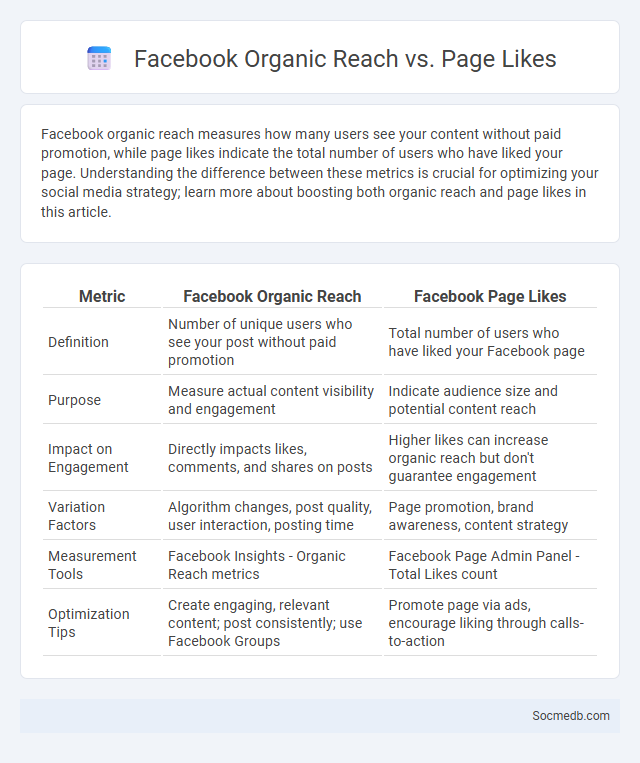
Photo illustration: Facebook Organic Reach vs Page Likes
Facebook organic reach measures how many users see your content without paid promotion, while page likes indicate the total number of users who have liked your page. Understanding the difference between these metrics is crucial for optimizing your social media strategy; learn more about boosting both organic reach and page likes in this article.
Table of Comparison
| Metric | Facebook Organic Reach | Facebook Page Likes |
|---|---|---|
| Definition | Number of unique users who see your post without paid promotion | Total number of users who have liked your Facebook page |
| Purpose | Measure actual content visibility and engagement | Indicate audience size and potential content reach |
| Impact on Engagement | Directly impacts likes, comments, and shares on posts | Higher likes can increase organic reach but don't guarantee engagement |
| Variation Factors | Algorithm changes, post quality, user interaction, posting time | Page promotion, brand awareness, content strategy |
| Measurement Tools | Facebook Insights - Organic Reach metrics | Facebook Page Admin Panel - Total Likes count |
| Optimization Tips | Create engaging, relevant content; post consistently; use Facebook Groups | Promote page via ads, encourage liking through calls-to-action |
Understanding Facebook Organic Reach
Facebook organic reach refers to the number of unique users who see your content without paid distribution. Algorithms prioritize posts from friends and family, which means your content must be engaging and relevant to appear in users' feeds. To boost your organic reach, create high-quality posts that encourage interaction and leverage audience insights to tailor your messaging effectively.
The Significance of Page Likes
Page likes on social media platforms indicate audience interest and enhance your brand's visibility by boosting content reach through algorithm prioritization. High numbers of page likes build social proof, establishing credibility and attracting potential customers or followers. You can leverage these likes to improve engagement metrics and tailor marketing strategies for better conversion rates.
Organic Reach vs Page Likes: Key Differences
Organic reach measures the number of unique users who see a post without paid promotion, reflecting genuine engagement and content relevance on platforms like Facebook and Instagram. Page likes indicate the total number of users who have chosen to follow a page, serving as a metric for potential audience size but not guaranteeing active interaction or visibility. Understanding the distinction helps marketers optimize content strategies to boost authentic visibility rather than relying solely on follower counts.
Factors Affecting Organic Reach on Facebook
Facebook's organic reach is influenced by several key factors including content relevance, user engagement, and algorithm changes. High-quality posts that encourage likes, comments, and shares increase visibility within your network, while Facebook's algorithm prioritizes interactions with friends and family over brand pages. Understanding these elements helps you craft strategies that enhance Your content's exposure without relying on paid promotions.
How Facebook’s Algorithm Impacts Organic Reach
Facebook's algorithm prioritizes content based on user engagement metrics such as likes, comments, and shares, significantly limiting organic reach for pages with low interaction rates. Posts from friends and family are favored over brand content, compelling businesses to invest in targeted ads to maintain visibility. Frequent algorithm updates continuously reshape content distribution, making strategic optimization essential for maximizing organic reach on the platform.
The Decline of Organic Reach Over Time
Organic reach on social media platforms has significantly declined over time due to algorithm changes prioritizing paid content and user engagement signals. Your content now faces increased competition, making it harder to appear in followers' feeds without paid promotion or strategic optimization. Adapting to evolving platform algorithms and leveraging targeted ads are essential for maintaining visibility and engagement.
Strategies to Boost Organic Reach Without Paid Ads
Leveraging consistent, high-quality content tailored to your target audience enhances organic reach on social media platforms. You should engage authentically by responding to comments and participating in relevant community discussions to build trust and increase visibility. Utilizing SEO-friendly hashtags and optimizing post timing based on user activity insights further maximizes your content's discoverability without relying on paid ads.
Are Page Likes Still Relevant in 2024?
Page likes remain a valuable metric in 2024 for measuring social media popularity and credibility, though engagement rates and content quality hold greater importance in algorithm ranking. Your focus should be on fostering authentic interactions and creating shareable content, as platforms prioritize meaningful connections over sheer like counts. Maintaining a solid base of page likes can boost brand visibility, but integrating multi-metric strategies is essential for long-term growth.
Measuring Success: Reach vs Engagement Metrics
Measuring social media success requires analyzing both reach and engagement metrics to gain a comprehensive understanding of performance. Reach quantifies the total number of unique users exposed to the content, highlighting brand awareness potential, while engagement metrics--such as likes, comments, shares, and click-through rates--reflect audience interaction and content relevance. Prioritizing engagement over reach helps marketers identify valuable connections and drive meaningful audience actions essential for campaign effectiveness.
Best Practices for Maximizing Facebook Presence
Consistently posting high-quality, engaging content tailored to your target audience boosts visibility and interaction on Facebook. Utilizing Facebook Insights allows for precise analysis of user behavior and content performance to optimize posting times and types. Engaging with followers through comments, messages, and interactive features like polls enhances community building and brand loyalty.
 socmedb.com
socmedb.com